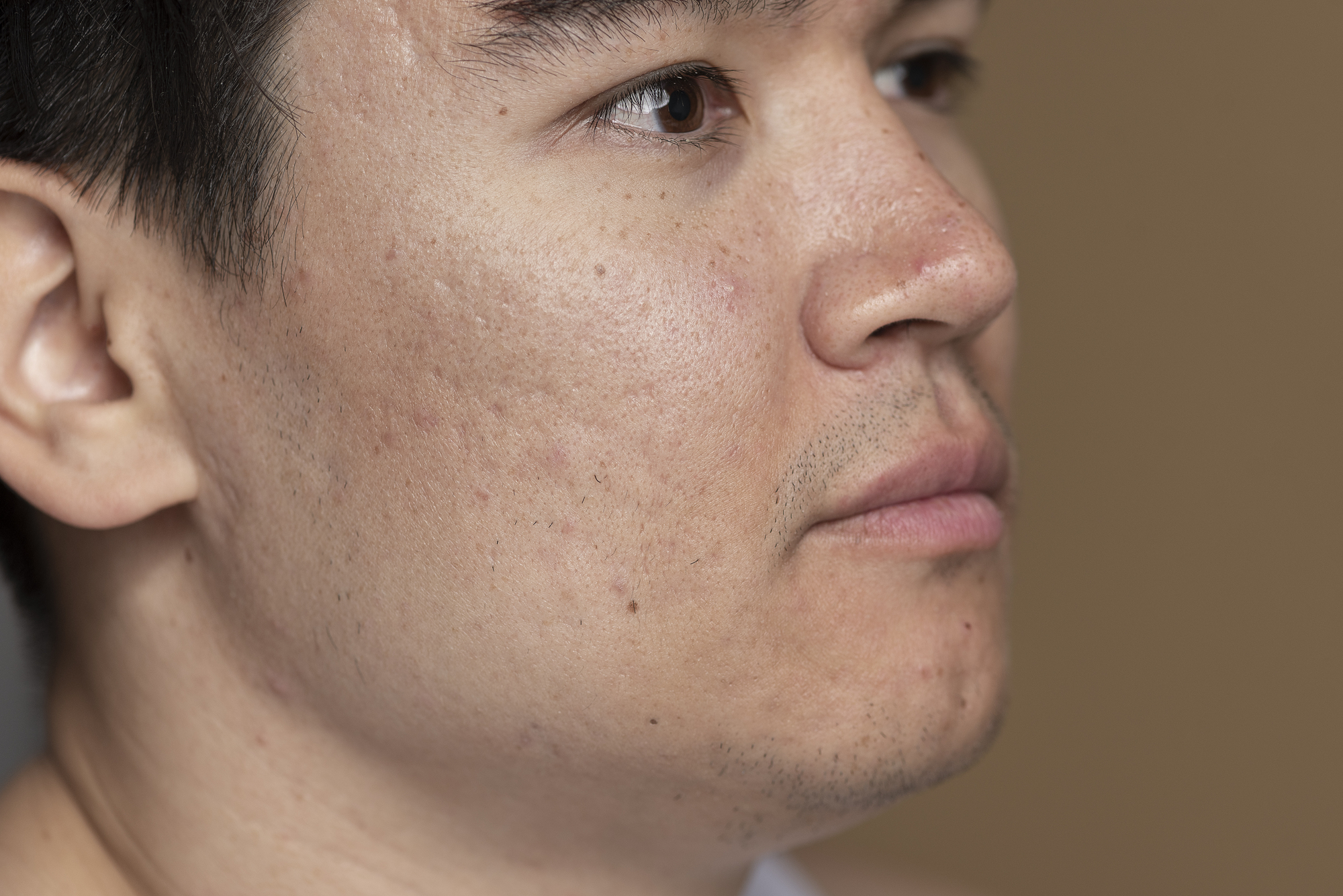Open Pores: Causes, Treatments, Results & Prevention
Open pores are a common concern, particularly for oily or combination skin. They can impact the texture and appearance of your skin, so it’s crucial to address them. In this guide, we’ll delve into the underlying factors that contribute to open pores and offer insights into how you can achieve smoother, more radiant skin.
What Are Open Pores?
Open pores, often more noticeable in the ‘t-zone’ of the face, refer to enlarged skin pores that allow the skin to breathe by releasing natural oil known as sebum. They can affect the texture of the skin and become a cosmetic concern.
What Causes Open Pores
Understanding the causes of open pores is crucial to combat the condition. Here are the factors contributing to their occurrence —
Excessive Sebum Production
Excessive sebum production, also known as seborrhea, occurs when the sebaceous glands in your skin produce an overabundance of natural oil called sebum. These glands are located in your pores and keep your skin lubricated and protected. Excess sebum can mix with dead skin cells, dirt, and debris on the skin’s surface. This combination can clog the pores, leading to the formation of comedones (blackheads and whiteheads). The accumulation of material within the pore can stretch and enlarge it, making it more visible.
People with oily or combination skin types are more prone to excessive sebum production, and as a result, they may be more likely to experience enlarged or prominent pores. Proper skincare, including regular cleansing, can help manage sebum levels.
Increased hair follicle volume
Increased hair follicle volume can contribute to the appearance of larger and more prominent pores. Hair follicles are located within the same openings as your skin pores, and their size can vary from person to person. When the hair follicles are thicker or have a larger volume, it can lead to a widening of the follicular openings. This widening effect can make the surrounding skin pores appear more prominent and noticeable. The size of hair follicles is partly determined by genetics and can vary across different body regions.
Furthermore, factors such as hormonal changes, aging, and even certain medical conditions can influence the size and thickness of hair follicles. While you can’t change the size of your hair follicles, you can address the appearance of prominent pores by maintaining a consistent skincare routine, protecting your skin from sun damage, and considering professional treatments like chemical peels or laser therapy.
Heredity
Heredity plays a significant role in determining the size of your pores. Your genetic predisposition can influence the structure and characteristics of your skin, including the size of your pores. If your parents or close relatives have naturally larger pores, you are more likely to inherit this trait. Likewise, individuals from certain ethnic backgrounds may be genetically predisposed to smaller or larger pores.
Ageing & Sun Exposure
Aging and sun exposure are external factors that can significantly impact the appearance of pores. As you age, your skin undergoes several changes, including a reduction in the production of collagen and elastin fibers, essential for maintaining skin elasticity and firmness. Collagen and elastin provide structural support to your skin, and when their production decreases, the skin becomes less able to bounce back into its original shape. This loss of elasticity can cause the skin to sag, making pores more noticeable and appear larger than when you were younger.
On the other hand, prolonged exposure to the sun’s harmful UV rays can lead to photoaging, a process that accelerates the breakdown of collagen and elastin fibers. This damage can result in premature skin aging, causing the skin to lose its natural suppleness and allowing pores to become more conspicuous.
Hormonal Changes
Hormonal changes can have a profound impact on the size and visibility of pores. Fluctuations in hormone levels, which can occur during various life stages such as puberty, pregnancy, menstruation, and menopause, can stimulate the sebaceous glands in your skin. When hormonal fluctuations lead to an increase in sebum production, the excess oil can mix with dead skin cells and other debris, clogging the pores. This can result in the pores appearing larger and more prominent.
In particular, conditions like acne and polycystic ovary syndrome (PCOS) are associated with hormonal imbalances that can lead to enlarged pores. Managing these hormonal fluctuations through proper medical treatment and skincare can help control sebum production and reduce the visibility of open pores.
Diagnosing Large Open Pores
Dermatologists diagnose open pores through physical examinations, considering factors such as pore size, location, and severity. They also review your family and medical history, hormonal health, and lifestyle habits to identify underlying causes. Based on these assessments, a personalized treatment plan is recommended to reduce the visibility of open pores.
While open pores are generally not a serious medical concern, significant changes in pore size, distribution, or density warrant consultation with a dermatologist.
Treatment for Large Open Pores
For effective treatment, it is essential to consult a dermatologist rather than attempting self-care. Over-the-counter products may provide temporary results, but they can also lead to side effects. Dermatologists can recommend suitable skincare products or aesthetic procedures tailored to your skin type and the underlying causes of open pores. Advanced treatments effectively address open pores caused by various factors. These treatments may include:
- Topical Therapies: Such as Tretinoin, topical nicotinamide, Vitamin C, or AHAs to diminish open pores.
- Oral Medications: Dermatologists may prescribe oral medicines like oral retinoids or antiandrogens to treat hormonal causes of open pores.
- Laser Toning: Advanced lasers can stimulate collagen production and minimize the appearance of open pores.
- Fractional Micro-Needling Radiofrequency (MNRF): This procedure stimulates collagen and elastin production, reducing the visibility of enlarged pores.
- Chemical Peels: Controlled exfoliation with peels can help reduce large skin pores.
- Comedone Extraction: Specialized tools may be used to remove blackheads and whiteheads, preventing pore clogging.
Preventing Large Open Pores
Prevention is key. You can take steps to prevent open pores from becoming more noticeable —
- Clean: Use a gentle, non-comedogenic cleanser twice daily to unclog pores.
- Protect: Apply sunscreen with SPF 30+ daily to prevent premature skin aging due to sun damage.
- Nourish: Use water-based moisturizers suitable for your skin type.
While no treatment can permanently remove pores from your face, advanced dermatological procedures can significantly reduce their appearance, leaving you with smoother, more radiant skin.
Frequently Asked Questions
- Are Acne Scars and Open Pores Different?
Yes, they are. Open pores can result from excess sebum production, hormonal issues, sun exposure, etc. They may eventually lead to acne and scars.
- Can You Close Open Pores Permanently?
Let’s be real here! It’s not possible to permanently close open pores, as they serve a vital function in maintaining healthy skin. However, excessively visible pores can be treated with advanced procedures like chemical peeling.
- Do Open Pores Cause Acne?
Open pores do not directly cause acne. However, they can be a sign of excess sebum production, which may lead to acne.
- Can You Cure Open Pores?
Let’s face it – open pores are not curable. However, they can be effectively minimized with medical-aesthetic treatments.
- Are Open Pores Bad?
Open pores are common, and they don’t point to any serious medical condition. However, they can affect the texture and appearance of your skin. These days, effective treatments are available to manage open pores.
Manage Open Pores Effectively With Labelle
Tried numerous ways but couldn’t find a working solution to manage open pores. Reach out to Labelle! The experts of Labelle can identify the underlying reason and come up with a curated open pores treatment plan suitable for your individual requirements. Embrace the Labelle way, and get care-free, radiant skin!
Get Free Consultation
